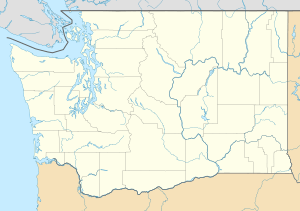Ridgefield National Wildlife Refuge facts for kids
Quick facts for kids Ridgefield National Wildlife Refuge |
|
|---|---|
|
IUCN Category IV (Habitat/Species Management Area)
|
|
 |
|
| Location | Clark County, Washington, United States |
| Nearest city | Vancouver, Washington |
| Area | 5,228.10 acres (21.1574 km2) |
| Established | 1965 |
| Visitors | 165,000 |
| Governing body | United States Fish and Wildlife Service |
| Website | Ridgefield National Wildlife Refuge |
The Ridgefield National Wildlife Refuge is a special place in Clark County, Washington, where wild animals are protected. It is managed by the United States Fish and Wildlife Service. This refuge covers more than 5,200 acres of marshes, grasslands, and woodlands.
The refuge was created in 1965. It was set up to provide a safe winter home for waterfowl (birds that live near water). A main goal was to help the dusky Canada goose. Their nesting areas in Alaska were badly affected by a strong earthquake in 1964.
Ridgefield NWR is part of a larger group called the Ridgefield National Wildlife Refuge Complex. This complex manages four refuges in southwestern Washington. These include Ridgefield, Franz Lake, Pierce, and Steigerwald Lake. In recent years, new buildings have been added to help the staff and visitors.
Contents
Exploring the Refuge
The Ridgefield National Wildlife Refuge has different areas, or "units," each with its own purpose.
Carty Unit
The Carty Unit helps protect the natural Columbia River floodplain. This area has a 2-mile (3 km) hiking trail where you can explore on your own.
River 'S' and Bachelor Island Units
The River 'S' and Bachelor Island units are managed to provide the best possible home for waterfowl and other wetland animals. The River 'S' unit has a 4.2-mile (7 km) auto tour route. You can drive through this area to see the wildlife. It also has a 1.2-mile (2 km) hiking trail that is open during certain times of the year.
Amazing Wildlife
The refuge is home to many different animals, especially birds.
Birds
Many birds visit the refuge during their spring and fall migrations. You might see tall sandhill cranes, various shorebirds, and many kinds of songbirds. Some birds live here all year round and build their nests in the refuge. These include mallards, Canada geese, great blue herons, pheasants, ruffed grouse, barn owls, great horned owls, bald eagles, ospreys, and red-tailed hawks.
Mammals
The largest mammals you might find at the refuge are Black-tailed deer and cougars. Smaller mammals are also present. These include coyotes, red foxes, raccoons, skunks, porcupines, bobcats, beavers, minks, river otters, muskrats, badgers, and brush rabbits. You might spot them if you are lucky!
Historic Quarries
The Carty Unit of the refuge also has seven old quarries. A quarry is a place where stone is dug out of the ground. These quarries are listed on the National Register of Historic Places. This means they are important historical sites.


